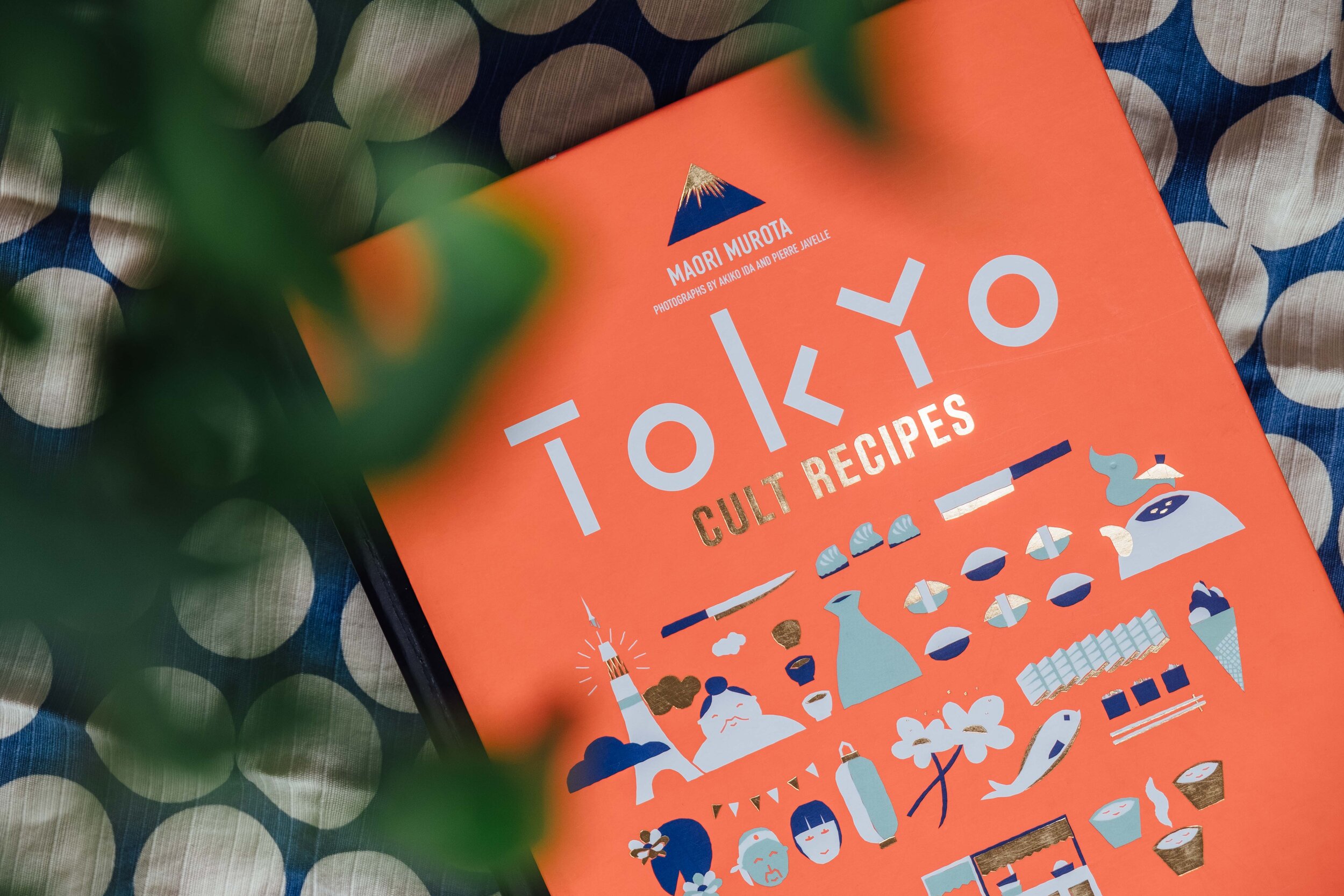The best Japanese Cookbooks
If you like sake, chances are you like Japanese food, too. Here we have compiled a few of our favourite Japanese cookbooks. Some are rightfully well-known, but there might be a few unexpected gems as well!
And if you have a personal favourite that’s not included here, let us know in the comments or DM us on instagram!
What’s kuzu again? – Richard Hosking’s A Dictionary of Japanese Food has all the answers.
A Dictionary of Japanese Food
At first, let’s get a good overview of Japanese foodstuffs, kitchen utensils and techniques. As the name says, the Dictionary of Japanese Food by Richard Hosking is not a cookbook per se, but it deserves to have a place on your kitchen shelf.
It’s an indispensable resource when you stumble across an unknown ingredient in a recipe. Each term is written in Latin letters, kana (Japanese syllabic alphabet) and kanji (ideographic characters) and then explained, sometimes including a small illustration. In the appendices, Hosking looks a bit deeper into a few key ingredients and some aspects of Japanese food culture, which makes for an interesting read on its own.
Richard Hosking
A Dictionary of Japanese Food – Ingredients and Culture
2015, Tuttle Publishing, North Clarendon, VT
224 pages, b/w illustrations, softcover
Price: around 10–15 EUR
Japanese Home Style Cooking
Don’t judge this book by its cover! It’s one of the most useful basic cookbooks, containing all the classics of a Japanese home kitchen.
Better Home Japan was founded in 1963, when supermarkets and electric kitchen appliances were still novelties, to educate consumers and to promote healthy Japanese food. They have published a number of cookbooks in Japanese and also run cooking schools in various parts of the country.
Japanese Home Style Cooking was first published in 1986 and looks the part. But don’t let that fool you. With its varied, authentic, and simple recipes, it’s one of the best introductions to real Japanese home cooking you can find. A short introduction to the most common Japanese ingredients is also included.
Mihoko Hoshino
Japanese Home Style Cooking
1996, Heian International / Better Home Japan
96 pages, photos, hardcover
Price: around 10 EUR
Authentic and fun: Tokyo Cult Recipes is a great introduction to modern Japanese cooking.
Tokyo Cult Recipes
Tokyo Cult Recipes offers a much more modern take on Japanese home cooking. The book is part of a series that explores local cuisines around the world: you can find “cult recipes” from such trendy places as Copenhagen and Venice, too, among others.
The author of the Tokyo cookbook, Maori Murata, grew up in Tokyo and now lives in Paris where she works as a private chef and event caterer. Her personal style and passion for food shine through in every recipe and in the beautiful photographs. The recipes cover everything from breakfast and lunch to family dinners, snacks and desserts.
All recipes are easy to follow, with step-by-step photographs and illustrations to help you through more tricky parts. The selection reflects what many typical families in Japan might cook at home – the dishes are not limited to traditional Japanese foods but also include modern classics like omurice and matcha-flavoured ice cream.
Maori Murota
Tokyo Cult Recipes
2015, Murdoch books, Sydney/London
272 pages, photos, hardcover
Price: around 18 EUR
Note for our German readers: Die deutsche Version dieses Buches ist, wenn man den Rezensionen glauben darf, sehr schlecht übersetzt. Kauft lieber die englischsprachige Ausgabe.
Elizabeth Andoh’s thoughtful approach to Japanese cooking has made her books modern classics.
Washoku – Recipes from the Japanese Home Kitchen
Elizabeth Andoh’s cookbooks are well-known for good reasons. Her deep understanding of Japanese ingredients and techniques, flavour combinations, and culinary history is evident in each and every one of her well-balanced recipes.
Washoku is the Japanese term for what is considered traditionally Japanese food, as opposed to yoshoku – western(-influenced) food. Andoh places great emphasis on harmony in the kitchen and at the table, from being conscious about how you work and eat, to practical things like reducing waste by re-using cuttings and leftovers.
Her book is a well-structured masterclass in Japanese cooking that covers all parts. Ingredients and techniques are thoroughly explained, and are sometimes also put further into context with regards to their cultural significance. The recipes are easy to follow, very authentic and true to the spirit of washoku cuisine with balanced, delicious and healthy dishes.
Beginners in the kitchen, however, might be better off starting with one of the more approachable books above. Washoku is at times a little text-heavy and creating a classic Japanese meal with multiple side dishes can be a lot of work.
Elizabeth Andoh also has a book on the often overlooked vegan and vegetarian traditions of Japan, which have their origin in the kitchens of Buddhist temples.
Elizabeth Andoh
Washoku: Recipes from the Japanese Home Kitchen
2005, Ten Speed Press, Berkeley, CA
328 pages, photos, hardcover
Price: around 35 EUR
Kansha: Celebrating Japan's Vegan and Vegetarian Traditions
2010, Ten Speed Press, Berkeley, CA
304 pages, photos, hardcover
Price: around 30 EUR
Japanese Cooking – A simple Art
A thick book about a simple art.
This is the bible of Japanese cookbooks. Long out of print and traded at high prices, Shizuo Tsujis encyclopaedic volume was finally re-issued for its 25th anniversary in 2012.
The comprehensive book not only boasts over 200 recipes from Abe-kawa mochi to zosui, but also explains many Japanese ingredients, kitchen utensils, cutting and cooking techniques and cultural aspects. There is still no other English-language book that combines so much knowledge about Japanese cooking in one volume.
If you really want to dive deep into Japanese food, there’s no way around this book. There are only few photos, but line drawings do a good job of explaining cutting techniques and other important aspects. Definitely not for beginners, but full of valuable knowledge.
Shizuo Tsuji
Japanese Cooking – A Simple Art
2012, Kodansha International, Tokyo
508 pages, b/w illustrations, some photos, hardcover
Price: 35 EUR
Almost as good as a trip through Tokyo’s nightlife: Mark Robinson takes you on a tour of his favourite Japanese pubs.
Izakaya – The Japanese Pub Cookbook
Now here’s a cookbook for sake lovers! In Izakaya Mark Robinson takes us to some of his favourite neighborhood restaurants and bars in Tokyo, from old-school classics to modern gastro-pubs. A short text introduces each bar, the owner and their concept before we are treated to a selection of recipes for some of their most popular dishes. In between, there are also short sections about Japanese drinking and food culture, excursions into history and basic knowledge about key ingredients.
This mix makes the book very readable. Masashi Kuma’s many photos do the rest to get your mouth watering, so you will want to start cooking (and drinking) right away! Recipes include staples like potato salad and chilled tomato (yes, really! It’s great with Kewpie mayonnaise) but also creamy crab croquets and a scrumptious chicken escabeche.
Mark Robinson
Izakaya – The Japanese Pub Cookbook
2012, Kodansha International, Tokyo
160 pages, many photos, hardcover
Price: 25 EUR
Complete Japanese Cuisine
For the aspiring kaiseki-chef, there’s no way around the Japanese Culinary Academy’s Complete Japanese Cuisine.
Want to start your own high-class Japanese restaurant? These books will help you get started. The Japanese Culinary Academy is publishing an ongoing series of beautifully produced books aimed at a professional audience covering all aspects of Japanese cuisine.
Starting with an introduction to nature, history and culture, these books are a valuable resource as well as a feast for the eyes. Even if you won’t cook any of the elaborate dishes, it’s an inspiring and beautiful book that doesn’t look out of place on a coffee table.
If you are already knowledgable in the basics of Japanese cooking, some of the essays might not quite have the depth you would be hoping for. This is especially true of the first two volumes. The two books on cutting techniques are much more hands-on and deliver detailed step-by step instructions with many photos.
The Japanese Culinary Academy's Complete Japanese Cuisine
Vol. 1 – Introduction to Japanese Cuisine: Nature, History and Culture
Vol. 2 – Flavor and Seasonings: Dashi, Umami and Fermented Foods
Vol. 3 – Mukoita I, Cutting Techniques: Fish
Vol. 4 – Mukoita II, Cutting Techniques: Seafood, Poultry, and Vegetables
2015 – 2018, Shuhari Initiative, Kyoto
between 184 – 256 pages, many photos, hardcover
Price: 45 – 60 EUR
Roasted boar shoulder for Sunday dinner?
DEN – The Evolving Tokyo-Japanese Cuisine
Zaiyu Hasegawa’s Michelin-starred restaurant “DEN” has long been a must-visit for international foodies travelling to Tokyo. Their innovative cuisine blends Japanese and western techniques and ingredients while always staying true to the spirit of a formal Japanese kaiseki dinner.
Now you can recreate many of their signature dishes at home. Well, let’s be honest… chances are, only few of us are going to try a hand at these complex creations. But it’s still a very inspiring read and chef Hasegawa is very generously sharing not only ingredients and techniques but also his thoughts about Japanese food culture.
Zaiyu Hasegawa
DEN – The Evolving Tokyo-Japanese Cuisine
2017, Shibata Shoten, Tokyo
155 pages, photos, softcover
bilingual edition Japanese/English
Price: around 25–30 EUR
















